SPORTident Orienteering App Quick Start Guide
This quick start guide describes how to install the SPORTident Orienteering App, set it up and organise your first training session with the app. In addition to your Android smartphone, you will need a SPORTident Printer and a SPORTident Station (e.g. BSM8-USB “Mini Reader”) with a USB adapter cable.
Install the app on your Android device
- Make sure you have a Google account.
- Open your Android device and install the SPORTident Orienteering App from the Google Play Store.
Pair your SPORTident Printer with the app
The SPORTident Printer is designed to be used with the SPORTident Orienteering App. The printer connects via Bluetooth to your Android smartphone.
To connect the SPORTident Printer for the first time:
- Turn on the printer.
- Enable Bluetooth on your phone.
- Search for available Bluetooth devices on your phone. The printer should be visible as “SI-Printer xxxxx”, where xxxxx is the serial number noted on the package or on the back side of the printer.
- Connect the printer to your phone. The Bluetooth PIN for the connection is 5349.
- Set up the printer in the SPORTident Orienteering App. Go to Settings > Printer and choose the coupled printer. You can do a test print to verify the connection.
Now you can print results on the SPORTident Printer with the SPORTident Orienteering App.
Configure the app for your first use
You can customise the app to your needs.
- Open the app and watch the intro.
- Open Settings from the menu. The menu button is at the top right (look for the three dots).
- Select your language (default is system language).
- Select your printer, set “automatically print split times”.
- Print test data to check if the connection to the printer is working.
- Open User account from the menu.
- If you do not have an account, create it by tapping Create account.
- If your account was set up by SPORTident, please change the initial password.
- Sign in to your account with your username and password.
- Manage your subscription.
- Edit your account information like name, e-mail address and organisation/club.
- Enable event data to be synchronised with SPORTident Center: courses and maps, results, competitor database.
- Go back to the start screen.
Create your first training
- Press the red button [+] to add an event. Select Training.
- Set the name of the training.
- Switch on Publish results on the web to publish your results via SPORTident Center.
- Choose Show events in public lists to make the event visible in the public event list of SPORTident Center. Leave this option inactive if you want the results to be visible only to the participants of the training (who will see the link and a QR code on their printed split time sheet).
- Tap Create Training.
- Open Event setup from the menu. The setup will open with 3 tabs (event, classes and service).
- Check and if necessary correct the name, start date and end date of the event.
- Choose your event options. For a training all options are already selected.
- By default the following are active for trainings: Read personal data from SI-Card, Ask for personal data, Auto-generate courses and classes, Allow SI-Card reuse
- Scroll down and check the result link.
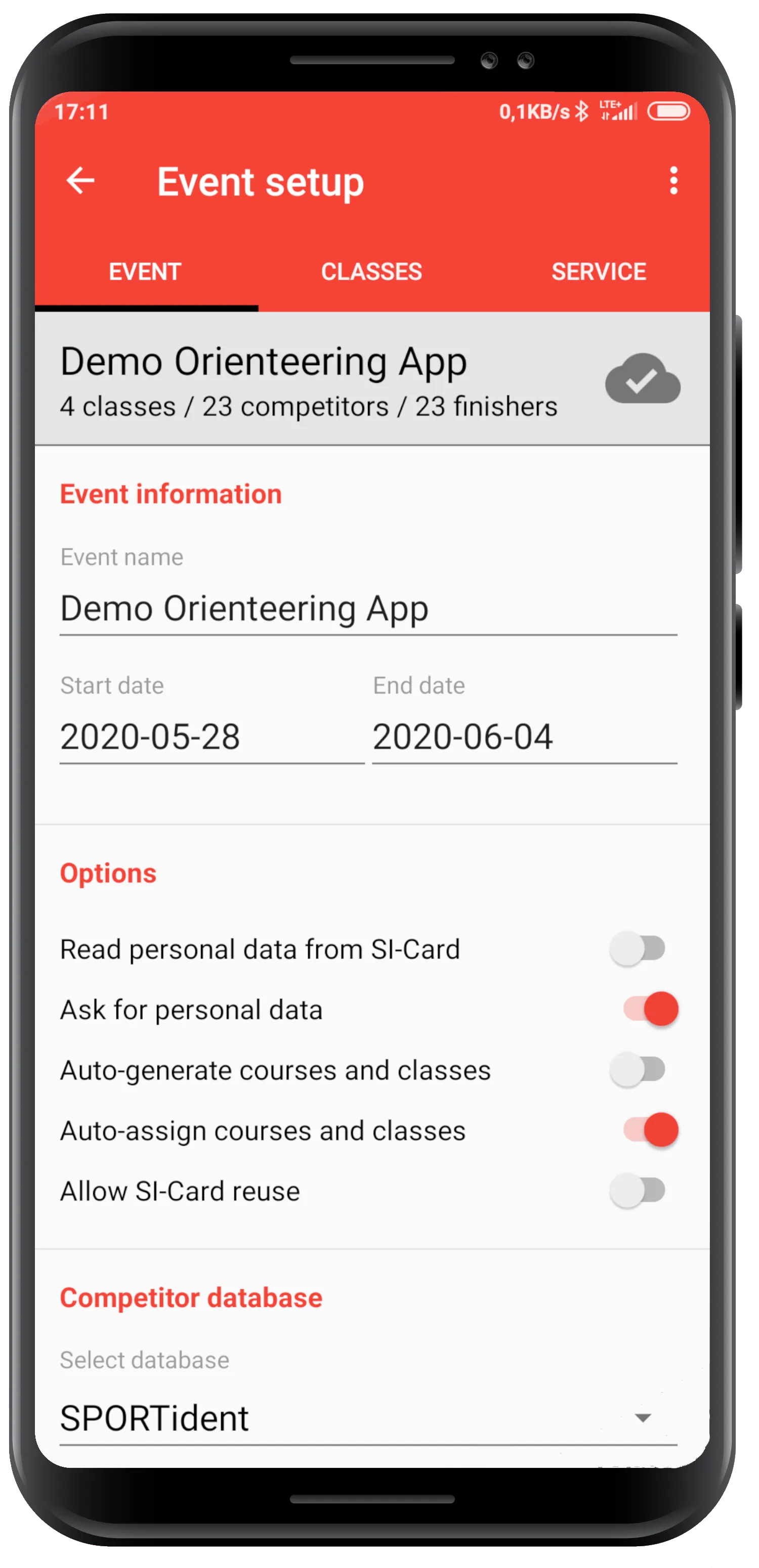
Start your first training
Preparation
- Make sure that the batteries of the smartphone/tablet and the SPORTident printer are charged.
- Set out the controls and hand out SI-Cards.
- Connect the SPORTident USB Station to your smartphone by using the USB adapter cable. The control panel changes from grey to green and shows “ready”.
- Switch on the SPORTident Printer.
Readout SI-Cards
- Hold the SI-Card in the hole of the read-out station until it confirms with a beep. The reading progress and the SI-Card number are displayed on the control panel.
- The registration screen opens. Here you can input information about the competitor and select/confirm the class. Save by tapping the tick at the top right.
- If Auto-generate courses and classes is active, as is the default in training mode, a new course is automatically generated for each control combination. If the participant made a mistake (too many, too few or some wrong controls), the correct course must be selected manually.
- When the course has been completed correctly, a green pop-up shows the runtime. Otherwise, the result is displayed with a red pop-up. In both cases the splits are printed automatically.
Results
- Switch to the Result tab. Tap on the red dot with the 3 dashes and a results menu opens.
- Tap on one of the red dots in the menu to use the respective functionality.
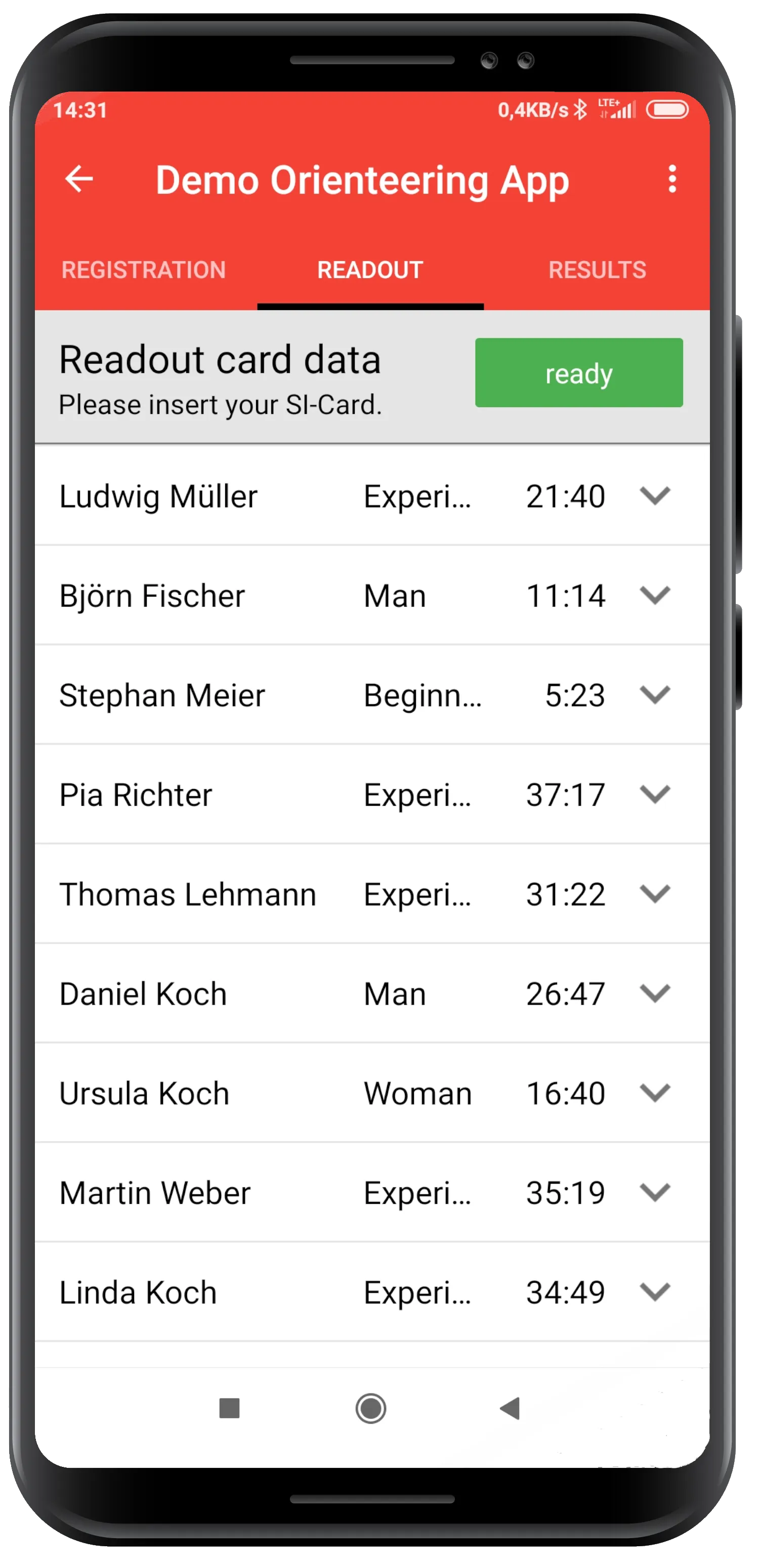

Advanced settings and options
Select suitable event options
The event setup menu allows you to configure your event. Available options are:
-
Read personal data from SI-Card
Personal information stored on the SI-Card is read out to pre-fill the registration form (or to skip the registration form altogether if asking for personal data is disabled). -
Ask for personal data
The registration screen opens after reading a SI-Card. You can then input the participant’s name and other personal data (or correct the information read from the card). Save by tapping the tick at the top right. -
Auto-generate courses and classes
A course is automatically created for each combination of controls. -
Auto-assign courses and classes
If the control codes match an already known course, the course is automatically assigned to the participants after reading out the SI-Card. If there is no exact match, either a new course is created (if auto-generate courses is enabled) or a manual course assignment is required. -
Allow SI-Card reuse
This function is particularly useful for children’s training or at schools, where multiple participants will use the same SI-Card for an event. After the SI-Card has been read, it can be assigned to the next participant.
Use the competitor database
You can create a competitor database and then use this data for your events to simplify the registration process. For example, you can store the information of all your club members in the database.
-
Create an Excel file in the SPORTident Orienteering App format with the rows as shown below.
ID CardNumber FirstName LastName Sex YearOfBirth Organisation City X-12271 8000001 John Smith M 1981 Fantastic Runners London X-13422 8000002 Jane Smith F 1980 Fantastic Runners London -
Store the Excel file as CSV with UTF-8 encoding (“CSV UTF-8”).
-
You can use SPORTident Center or the SPORTident Orienteering App for managing your competitor database.
- SPORTident Center: Sign in and open Competitor database
- SPORTident Orienteering App: Open your event, go to Event setup and tap on Manage databases.
-
Follow the instructions on the database page when importing/uploading the CSV file to SPORTident Center.
-
Open your event in the Orienteering App and go to Event setup. Scroll down and select the database.
-
The data set will then be available in the Registration and Readout sections and simplify and speed up the registration of participants. Competitors with a matching SI-Card number will automatically be selected. You also have the option to search for a participant by typing the name.
Enter courses and classes before start manually
You can create the courses and classes for your event in the app before the event.
- Open your event/training in the app.
- Go to Event setup and tap Classes.
- Tap the red plus button to open the Add class screen.
- Type the class name and create a new course or assign an already existing course.
- Edit the course information. Separate the individual control numbers (codes) with comma, for example “31,32,35,50,99”. Save by tapping the tick at the top right.
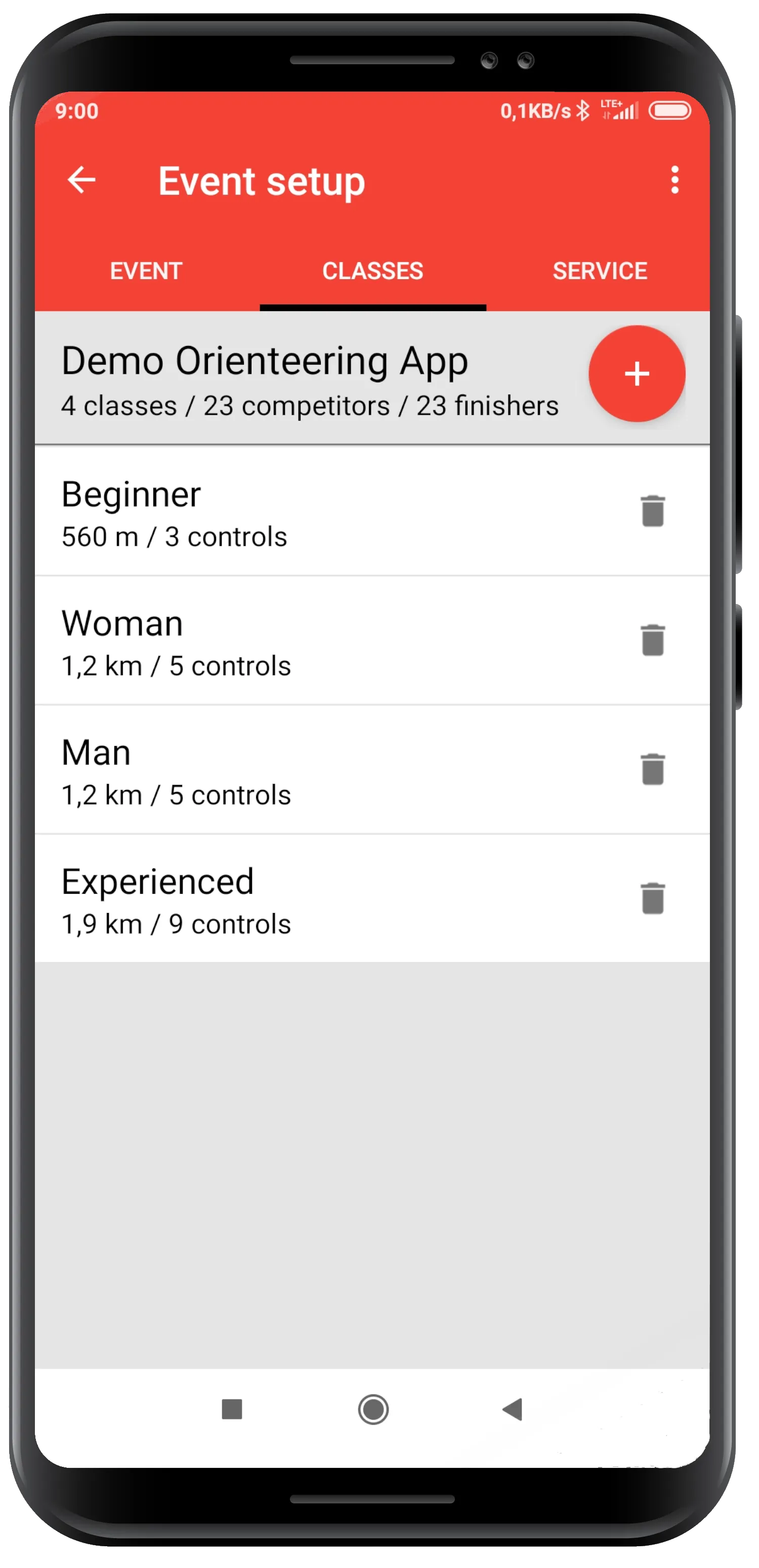
Enter courses and classes using OCAD
You can import the map and course and class definition from OCAD directly into SPORTident Center. For this function you need an OCAD Course setting licence or a OCAD Orienteering license. For further information visit OCAD.
- In OCAD open your course setting project. Make sure that the coordinate system for the map is set up correctly.
- Go to menu Course setting and select Upload to SPORTident Center.
- Sign-in to your SPORTident Center account.
- Select the event to which you want to upload the courses or create a new one.
- Update event data like name, date and time zone if necessary.
- Follow the steps to upload the course and map data to your event. Select the data and map resolution you want to upload from OCAD to SPORTident Center (the recommended resolution is “medium quality”). In the second step check the data and then click Upload to confirm.
- The process was successful if Up-to-date appears next to Check. The data is now available in SPORTident Center and from there will be automatically imported into your Orienteering App event. The process is finished and the window can be closed.
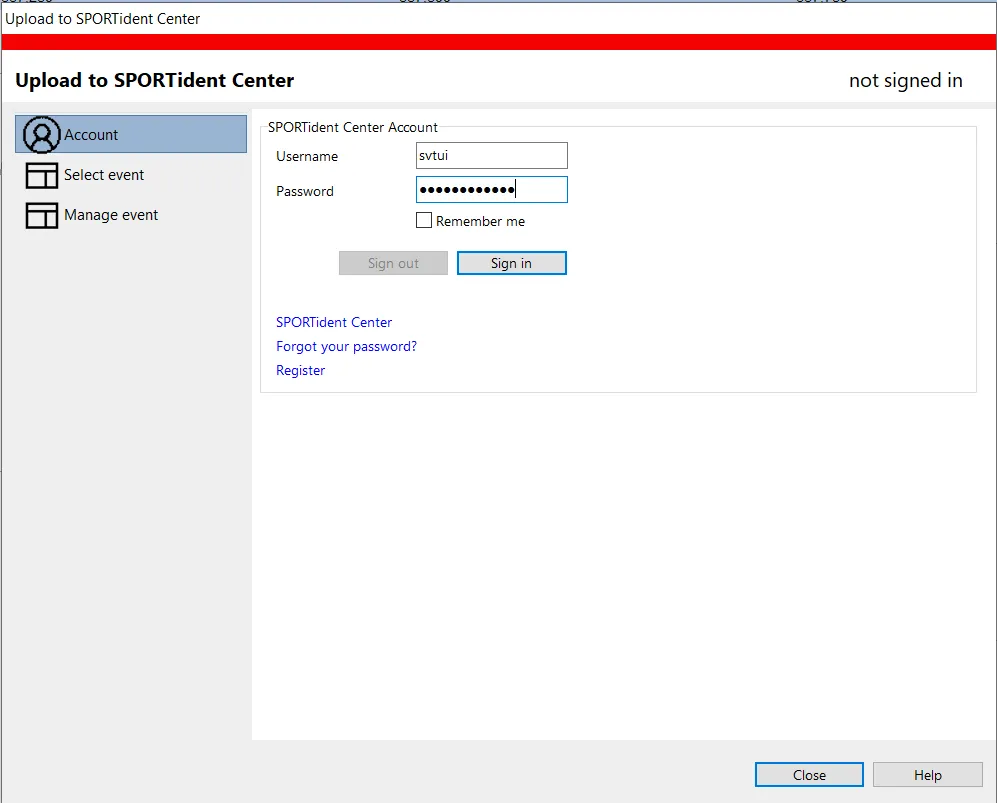
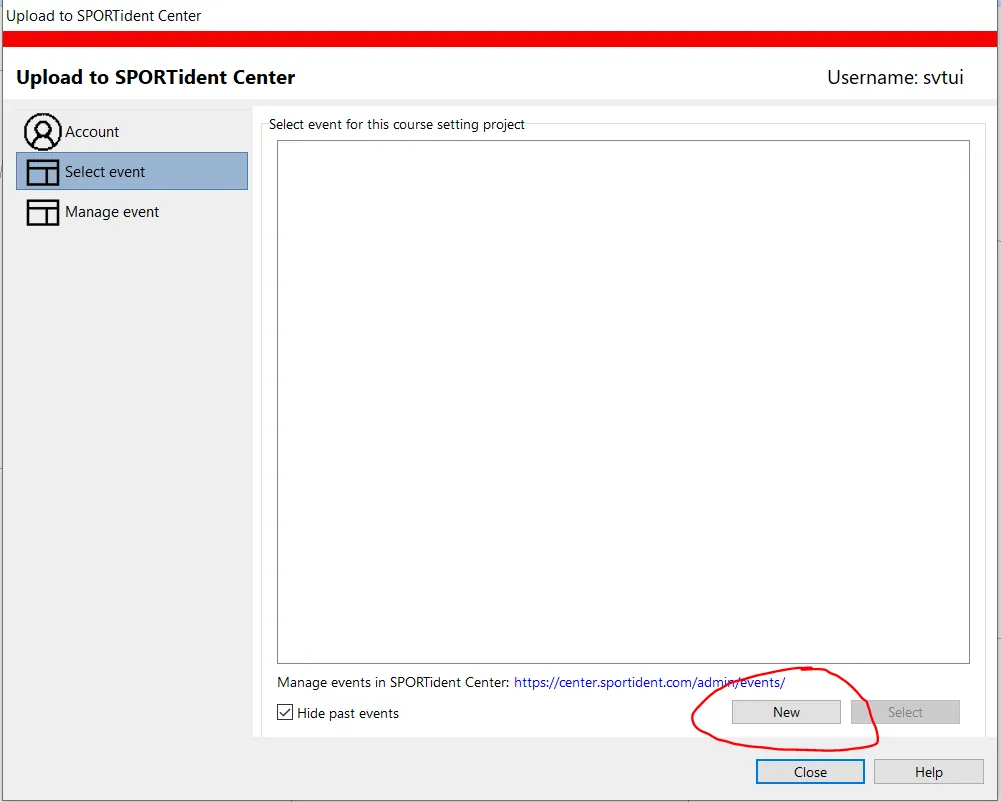
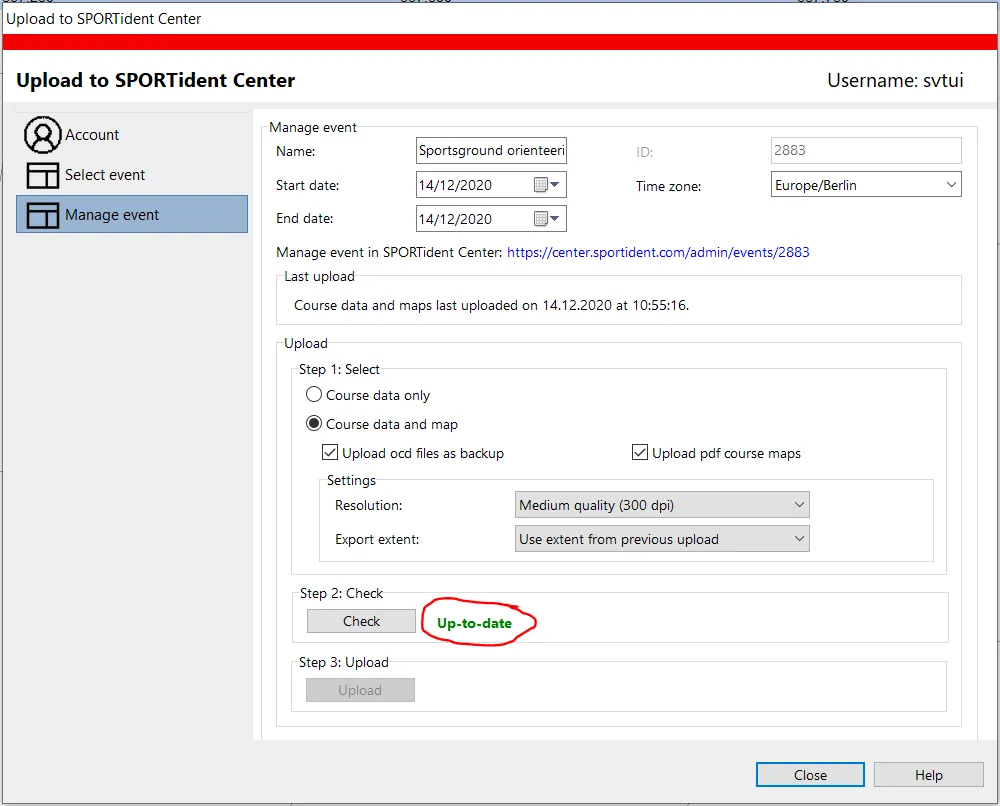
Event types supported by the Orienteering App
The SPORTident Orienteering App supports different types of orienteering events. The type of the event is selected as part of the class/course setup (go to Event setup > Classes).
Linear orienteering
In a classic orienteering event, each participant chooses a course with a linear sequence of controls. The control sequence can be specified manually or imported from OCAD as described above.
Score-O
For classic “Score-O” events, a network of controls is set up. Typically, each control is worth 1 point. Participants can visit the controls in any order. The winner is the person who completes the race the fastest.
You can specify the minimum number of points that have to be reached. Optionally, you can specify a time penalty that is applied per missing point.
Optionally, you can assign different points to your controls, e.g. “31[3], 32[3], 33[3], 41[4], 42[4]”.
Rogaining
For Rogaining, a network of controls is set up. Typically, the controls have different values (points). Participants can visit the controls in any order. The winner is the person who completes the race within the specified maximum running time with the most points. If the score of two participants is equal, the faster participant wins.
Optionally, you can specify penalty points for exceeding the maximum running time.
To assign points to the control codes, specify the points in square brackets, e.g. “31[3], 32[3], 33[3], 41[4], 42[4]”.
General options for courses and classes
If a start or finish control is not available, you have the option to use a regular control to time the start and/or finish by enabling the respective option.
Optionally, a mass start time can be specified per class. This start time will then apply to all participants assigned to this class.
Extended settings for courses
Extended settings are available by scrolling down in the Edit class view (go to Event setup > Classes). These settings are applied globally to all courses of the current event.
Missing controls
If a control station is missing or has been lost during an event, you can enter it as “missing”. Split times evaluation will ignore this particular control. The split time used is that of the previous control.
Enter the missing controls separated by a comma (and optionally a space). Example: “44, 67”
Replacement controls
It may be necessary to replace one station with another during an event. This can happen, for example, if the control station is defective or stolen.
The replacement is indicated by an arrow (”->”). Example: “81->35” specifies that control 35 has been replaced by control 81. Split time evaluation now accepts control number 81 when control number 35 is expected according to the course definition.
Neutralised course section
A neutralised course section is used, for example, for an unavoidable crossing over a busy road. This can result in different waiting times. Neutralising this course section allows for a fair competition.
You have the option to specify a maximum duration to prevent competitors from abusing time neutralisation for an excessively long recovery phase.
Example: Control 49 is set before the road crossing, 50 is set after the road crossing. You then specify “49-50[3:00]” to neutralize the time between these two controls for a maximum of 3 minutes.
Time offsets
Even with careful preparation, it can happen that the internal clock of a control station is set incorrectly. This can result in strange split times. In the app, such an error can be rectified by simply defining an offset.
Example: “31[-1:00:00], 32[+5:00]” For the control station with code 31, 1 hour is subtracted from the station time. For the control station with code 32, 5 minutes are added to the station time.